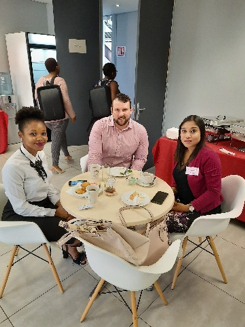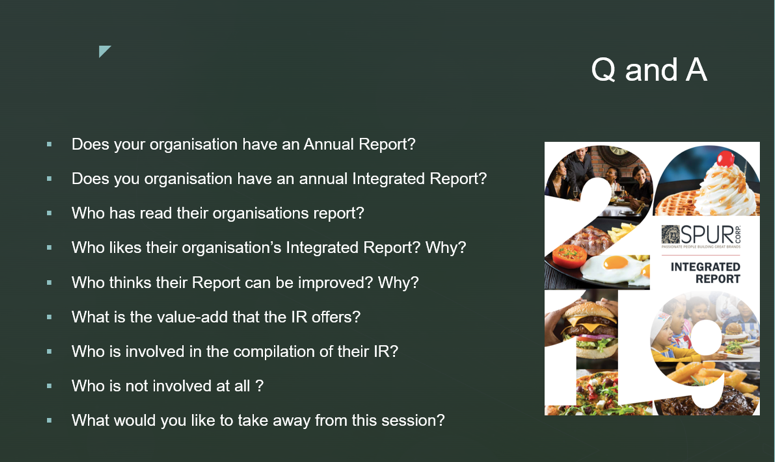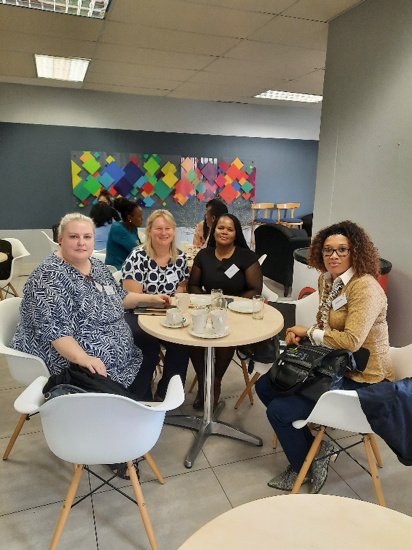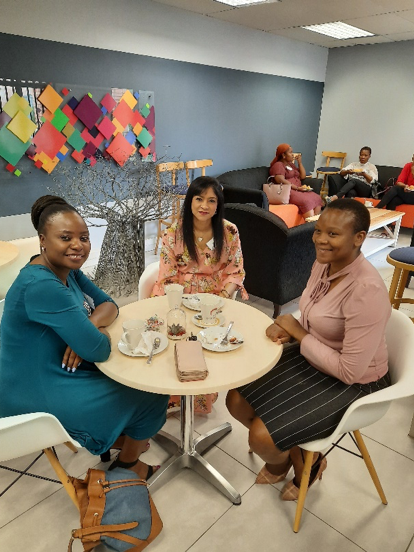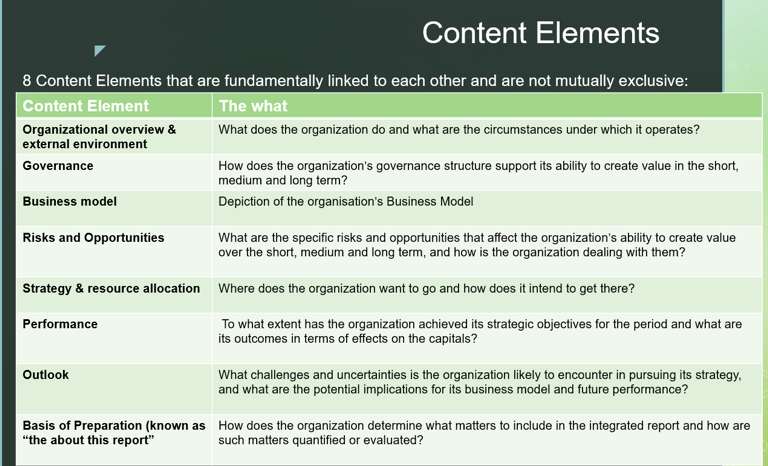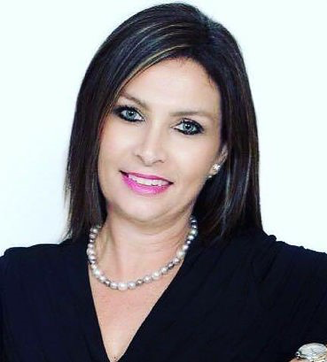BarnOwl Info Sharing session: 20 February 2020
Understanding the important role the Risk Function plays in the production of an organisation’s annual Integrated Report
Presented by Sheralee Morland, CEO, Joshero (Pty) Ltd
Thank you very much Sheralee for your interactive presentation at our BarnOwl info-sharing event held at the BarnOwl offices in Bryanston on the 20 February 2020.
Introduction:
Integrated Reporting is an approach that helps businesses think holistically about their strategy and plans, make informed decisions, manage key opportunities and risks to build investor and stakeholder confidence, and help manage the organisation’s performance:
Integrated reporting seeks to explain how the organisation interacts with the external environment and the capitals to create value over the short, medium and long term.
It is anticipated that IR will become the corporate norm; doing away with multiple, disconnected reports. It is already a stock exchange listing requirement in South Africa. Unlisted companies and not-for-profit organisations can voluntarily adopt to apply the International Integrated Reporting Framework (IIRF).
EY: “Integrated reporting is a way for a company to offer its stakeholders a holistic view of the financial and non-financial business impact”.
You will notice in the diagram above that ‘Risk and Opportunities’ is a fundamental component of Integrated Reporting. King IV advocates an outcomes based approach which means that it is expected of companies to consider the impact of their operations on the six capitals. In addition, King IV now requires the governing bodies of organisations to ensure that “active opportunity identification” is conducted. These are the stand-alone opportunities that are not necessarily aligned with any downside risk.
Food for thought:
What I liked about Sheralee’s presentation was that it was thought provoking and interactive and definitely not the run of the mill theoretical presentation. In fact, Sheralee started with the following Q&A slide, which we actively debated for quite some time. You may wish to ask yourself the following thought provoking questions:
Food for thought when considering whether we want our annual report to be an ‘honest and factual integrated report’ or just a ‘glossy magazine’ telling everyone how wonderful we are and possibly skirting around the real risks / issues:
- The risk management section of many an annual / integrated report looks very similar even so far as the actual risks identified go (e.g. attracting and retaining skills, sluggish economy, exchange rate, electricity supply, infrastructure constraints, policy and regulation, corruption etc.). Risks are often too high level (vague) in the report and couched ‘politely’ rather than calling it the way it is. To be of value and get the attention of our readers (stakeholders), risks need to be quantified where possible and supported by facts such as key indicators with actuals versus targets and how these stack up against the risk appetite. Perhaps we should be comparing risks year on year from previous reports to see whether the risks materialised and what the impact was on the business and / or how we mitigated the risks.
- Credibility comes from transparency, facts and figures and consequences either incurred or avoided. A glossy annual report is to be avoided at all costs versus a factual and transparent integrated report.
- The risks we list year after year are often events / incidents e.g. we know about electricity supply problems, water problems, skills problems, economic problems, policy & regulatory inhibitors, corruption, political interference etc. Yes, it’s important to know what we are doing to mitigate such risks / ongoing events and what their effect is on our business, however, are we also paying enough attention and applying our minds to risks on the horizon which may significantly affect our business in the future? (e.g. technology disrupters, renewable energy, robotics, AI, genetic engineering etc.) Obviously, we don’t have a crystal ball but we must ensure that we don’t miss the early warning signs which companies such as Kodak etc. missed. A wise man (my father) once said to me: ‘amber turns to red’ i.e. ‘amber does not turn to green’, certainly not our robots (traffic lights) in South Africa.
- How will we mitigate ‘reputational’ risk in a world of speed-of-light social media and no easy distinction between fake news and real news?
- How do we as risk officers and assurance providers report the bad news / corrupt activities without being suspended or losing our jobs or worse still being threatened? How does an organisation create a culture where ‘the messenger is not shot’? One way is to analyze the data and come up with the hard cold facts. As they say in golf ‘there are no comments on the scorecard’. If a sound organisation starts bleeding year after year after year (e.g. Steinhof, SAA, Eskom, SABC, PRASA etc.) surely it’s time to look at the facts and question (or better still actually do something about it) the competency of the leadership and its ethics.
- Everyone talks about the lack of skills in South Africa and special emergency visas to allow skilled people from outside SA to work here. It’s sad that in many cases our labour legislation inhibits the employment of our own South African skills. Looking at some of the hugely successful businesses in South Africa (e.g. Bidvest, Discovery, Investec, Naspers, etc.) built from scratch over the past few years by talented entrepreneurs; I personally don’t believe that we have a lack of business skills in South Africa as yet. Sadly, however this is changing fast as many talented entrepreneurs don’t see a future anymore in South Africa for themselves or their children. According to the 2020 IRMSA risk report the brain drain is running at +- 25,000 people leaving South Africa every year.
- As per the IRMSA 2020 risk report, South Africa is ranked at 139 out of 199 as the most difficult countries in the world to start a new business. Growing the economy by enabling SMMEs has been identified as a key initiative for the past 5 years now and yet nothing has happened; the economy has gone backwards. This initiative should be addressed urgently by government who desperately need additional funds from tax payers in order to keep South Africa going and to support social projects such as NHI.
In summary, perhaps it’s time for us to talk about the hard facts and the real risks in our integrated report instead of skirting around the issues in pursuit of a nice glossy annual ‘magazine’.
More on Integrated Reporting
Integrated thinking leads to integrated decision-making and actions that consider the creation of value over the short, medium and long term
The IIRC’s long-term vision is a world in which integrated thinking is embedded within mainstream business practice in the public and private sectors, facilitated by Integrated Reporting as the corporate reporting norm.
The cycle of integrated thinking and reporting, resulting in efficient and productive capital allocation, will act as a force for financial stability and sustainability.
Integrated Reporting seeks to explain how the organization interacts with the external environment and the capitals to create value over the short, medium and long term.
In summary
Integrated reporting, for any type of organisation, applies principles and concepts that are focused on bringing greater cohesion and efficiency to the reporting process, and adopting ‘integrated thinking’ as a way of breaking down internal silos and reducing duplication. It improves the quality of information available to providers of financial capital to enable a more efficient and productive allocation of capital. Its focus on value creation, and the capitals (financial, human, manufactured, social & relationship, natural and intellectual) used by the organisation to create value over time, contributes towards a more financially stable global economy, no matter how small the organisation is.
Sheralee comments that, “I believe that a well-constructed annual Integrated Report that tells the value creation story of an organisation is good for its brand and reputation and builds goodwill and trust. Contribute! Advise! Guide! Influence”’
For an example of a recent Integrated Report produced by Sheralee and describes the Value Creation process of the organisation, refer to:
https://sanbs.org.za/wp-content/uploads/2020/01/SANBS-AIR-2019__LoRes__27-Jan-2020.pdfnew.pdf
Should you need assistance with the production of your Integrated Report, or the role of Risk in its production, call Sheralee on 0741161262 or reach her on email sheralee.morland@joshero.com
Presentation and Video links:
Please see attached presentation here as well as video link here for more information.
Useful and associated links:
https://integratedreporting.org/wp-content/uploads/2013/12/13-12-08-THE-INTERNATIONAL-IR-FRAMEWORK-2-1.pdf
IRMSA 2020 risk report: https://api.barnowl.co.za/wp-content/uploads/2020/02/IRMSA-Risk-Report-20203180.pdf
https://api.barnowl.co.za/event/barnowl-information-sharing-session-29th-july-2016-on-the-integrated-report-and-integrated-thinking-in-the-reign-of-king-iv-by-leigh-roberts/ You can also find more information on www.integratedreportingsa.org
https://api.barnowl.co.za/event/information-sharing-session-27-july-2017/ The Role of the Future Risk Manager, Presented by Christopher Palm, Chief Risk Advisor, Institute of Risk Management SA (IRMSA). Let’s not sit outside the board room waiting to be called in to present our risk report and then be told “sorry but we’ve run out of time for you to present now; we take your risk report as ‘read’”.
https://api.barnowl.co.za/insights/king-iv-report-risk-compliance-and-assurance/
Please see https://api.barnowl.co.za/insights/risk-and-opportunity-a-new-paradigm-or-old-news/ written by Gert Christiaan Cruywagen
https://api.barnowl.co.za/selling-enterprise-risk-management-erm-to-the-board-and-the-executive/
https://coso.org/Documents/2017-COSO-ERM-Integrating-with-Strategy-and-Performance-Executive-Summary.pdf
https://barnowl.co.za/knowledge-centre/ and https://api.barnowl.co.za/videos/
https://youtu.be/X-Q0CA-bjQ4
Thank you:
Once again thank you Sheralee for your time and for your informative presentation and thank you to all those who attended our info sharing session. We look forward to seeing you at our next info sharing session. Please keep a look out for our upcoming events at: https://api.barnowl.co.za/events/
Kind regards
Jonathan Crisp
Director – BarnOwl GRC and Audit software
About by Sheralee Morland:
Sheralee has over 30 years of accumulated experience in governance related roles of internal auditing, assurance and risk management in banks, asset management, insurance, and mining organisations. She works with other professionals and organisations locally and internationally to:
- Understand the root cause of why their risk management is not delivering optimally/providing the return on investment
- Redirect focus on what matters in an organisation (incl. risks & opportunities to enhance/demonstrate value creation) – involving everyone in the risk management process (concept of ERM – “Everyone a Risk Manager”)
- Embed quality integrated ERM that is a fundamental component of Boards/Executives and Management decision making
- Create Risk Profiles which identify, with a wide range of stakeholders, the traditional and non- traditional risks/opportunities an organisation faces with suitable response and mitigating action plans (these take the form of bespoke sessions or training workshops).
- Create risk responsive & resilient organisations – able to navigate early identification of undesirable risks & an ability to bounce back & manage reputation
- Establish effective risk governance & committees at business, executive & Board levels
- Elevate Integrated Reporting to International Integrated Reporting Framework (IIRF) standards
- Produce annual Integrated Reports
Immediately prior to consulting, Sheralee held the post of Executive Head of Enterprise-wide Risk Management at Nedbank and included accountability for embedding risk management into business processes; Nedbank’s Risk Academy; Root Cause Analysis; Combined Assurance; Risk Communications and Awareness; Enterprise-wide Risk Management Framework; Risk Governance; risk frameworks; risk policies; charters; risk escalation; Board Risk Committee reporting and attendance at Group Risk and Capital Management Committee and multiple Business Risk Committees; Formulation of the Reg 39/40 reports for the regulators; member of integrated reporting team; etc.
Other roles include Old Mutual, Standard Bank, EY, and Anglo American (for the implementation of the Turnbull Guidance on Risk Management).
Sheralee has delivered several papers at governance, risk and integrated reporting conferences, regularly chairs such events and is frequently approached for insights into best practice. She is the immediate past President of the Institute of Risk Management of South Africa (IRMSA) and served on the Executive Committee for 9 years. This culminated in being awarded with Honorary Membership of IRMSA in 2018. She remains a member of the RemCo; FinanceCo, Cruywagen/IRMSA Foundation and chairs the EventsCo.
She was a member of the Board of Trustees of the Nedgroup Medical Aid and Chairman of the Risk Committee. We look forward to welcoming you!
About BarnOwl:
BarnOwl is a fully integrated governance, risk management, compliance and audit software solution used by over 200 organisations in Africa, Australasia, Europe and the UK. BarnOwl is a locally developed software solution and is the preferred risk management solution for the South African public sector supporting the National Treasury risk framework.
Please see www.barnowl.co.za for more information.

